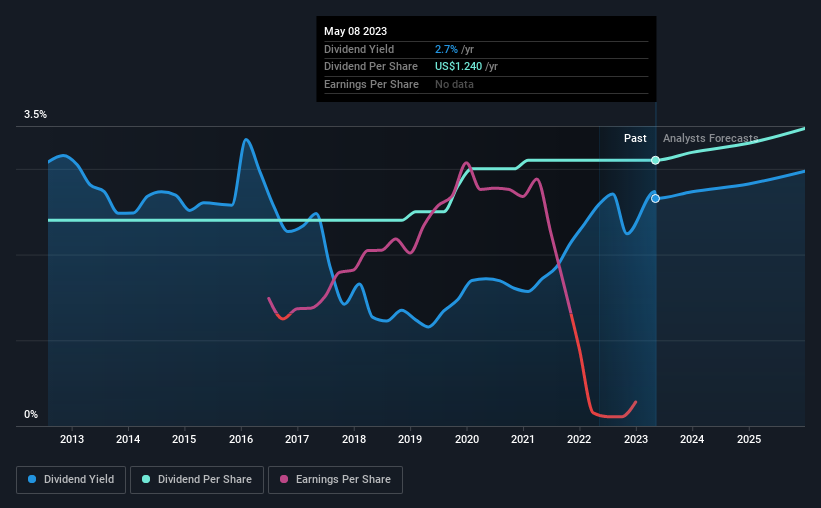Kemper Corporation (NYSE:KMPR) will pay a dividend of $0.31 on the 30th of May. Based on this payment, the dividend yield will be 2.7%, which is fairly typical for the industry.
While the dividend yield is important for income investors, it is also important to consider any large share price moves, as this will generally outweigh any gains from distributions. Kemper's stock price has reduced by 31% in the last 3 months, which is not ideal for investors and can explain a sharp increase in the dividend yield.
Check out our latest analysis for Kemper
Kemper's Dividend Is Well Covered By Earnings
While it is always good to see a solid dividend yield, we should also consider whether the payment is feasible. Even in the absence of profits, Kemper is paying a dividend. The company is also yet to generate cash flow, so the dividend sustainability is definitely questionable.
Analysts expect a massive rise in earnings per share in the next year. If the dividend extends its recent trend, estimates say the dividend could reach 4.4%, which we would be comfortable to see continuing.

Kemper Has A Solid Track Record
Even over a long history of paying dividends, the company's distributions have been remarkably stable. Since 2013, the annual payment back then was $0.96, compared to the most recent full-year payment of $1.24. This works out to be a compound annual growth rate (CAGR) of approximately 2.6% a year over that time. While the consistency in the dividend payments is impressive, we think the relatively slow rate of growth is less attractive.
Dividend Growth Potential Is Shaky
The company's investors will be pleased to have been receiving dividend income for some time. However, initial appearances might be deceiving. Earnings per share has been sinking by 36% over the last five years. A sharp decline in earnings per share is not great from from a dividend perspective. Even conservative payout ratios can come under pressure if earnings fall far enough. However, the next year is actually looking up, with earnings set to rise. We would just wait until it becomes a pattern before getting too excited.
Kemper's Dividend Doesn't Look Sustainable
In summary, while it's good to see that the dividend hasn't been cut, we are a bit cautious about Kemper's payments, as there could be some issues with sustaining them into the future. We can't deny that the payments have been very stable, but we are a little bit worried about the very high payout ratio. We would be a touch cautious of relying on this stock primarily for the dividend income.
Market movements attest to how highly valued a consistent dividend policy is compared to one which is more unpredictable. Still, investors need to consider a host of other factors, apart from dividend payments, when analysing a company. For instance, we've picked out 1 warning sign for Kemper that investors should take into consideration. If you are a dividend investor, you might also want to look at our curated list of high yield dividend stocks.
Valuation is complex, but we're here to simplify it.
Discover if Kemper might be undervalued or overvalued with our detailed analysis, featuring fair value estimates, potential risks, dividends, insider trades, and its financial condition.
Access Free AnalysisHave feedback on this article? Concerned about the content? Get in touch with us directly. Alternatively, email editorial-team (at) simplywallst.com.
This article by Simply Wall St is general in nature. We provide commentary based on historical data and analyst forecasts only using an unbiased methodology and our articles are not intended to be financial advice. It does not constitute a recommendation to buy or sell any stock, and does not take account of your objectives, or your financial situation. We aim to bring you long-term focused analysis driven by fundamental data. Note that our analysis may not factor in the latest price-sensitive company announcements or qualitative material. Simply Wall St has no position in any stocks mentioned.
About NYSE:KMPR
Kemper
An insurance holding company, provides insurance products in the United States.
Undervalued established dividend payer.
Similar Companies
Market Insights
Community Narratives


Recently Updated Narratives

TAV Havalimanlari Holding will fly high with 25.68% revenue growth


Fiducian: Compliance Clouds or Value Opportunity?


Q3 Outlook modestly optimistic
Popular Narratives


The company that turned a verb into a global necessity and basically runs the modern internet, digital ads, smartphones, maps, and AI.


MicroVision will explode future revenue by 380.37% with a vision towards success



